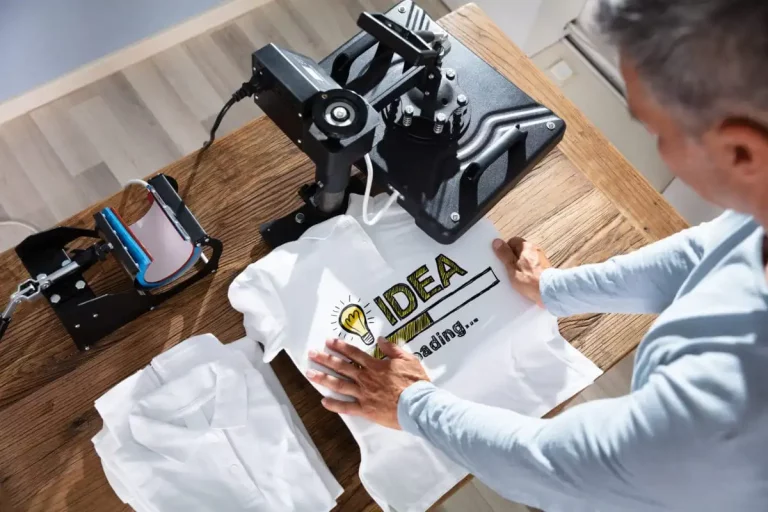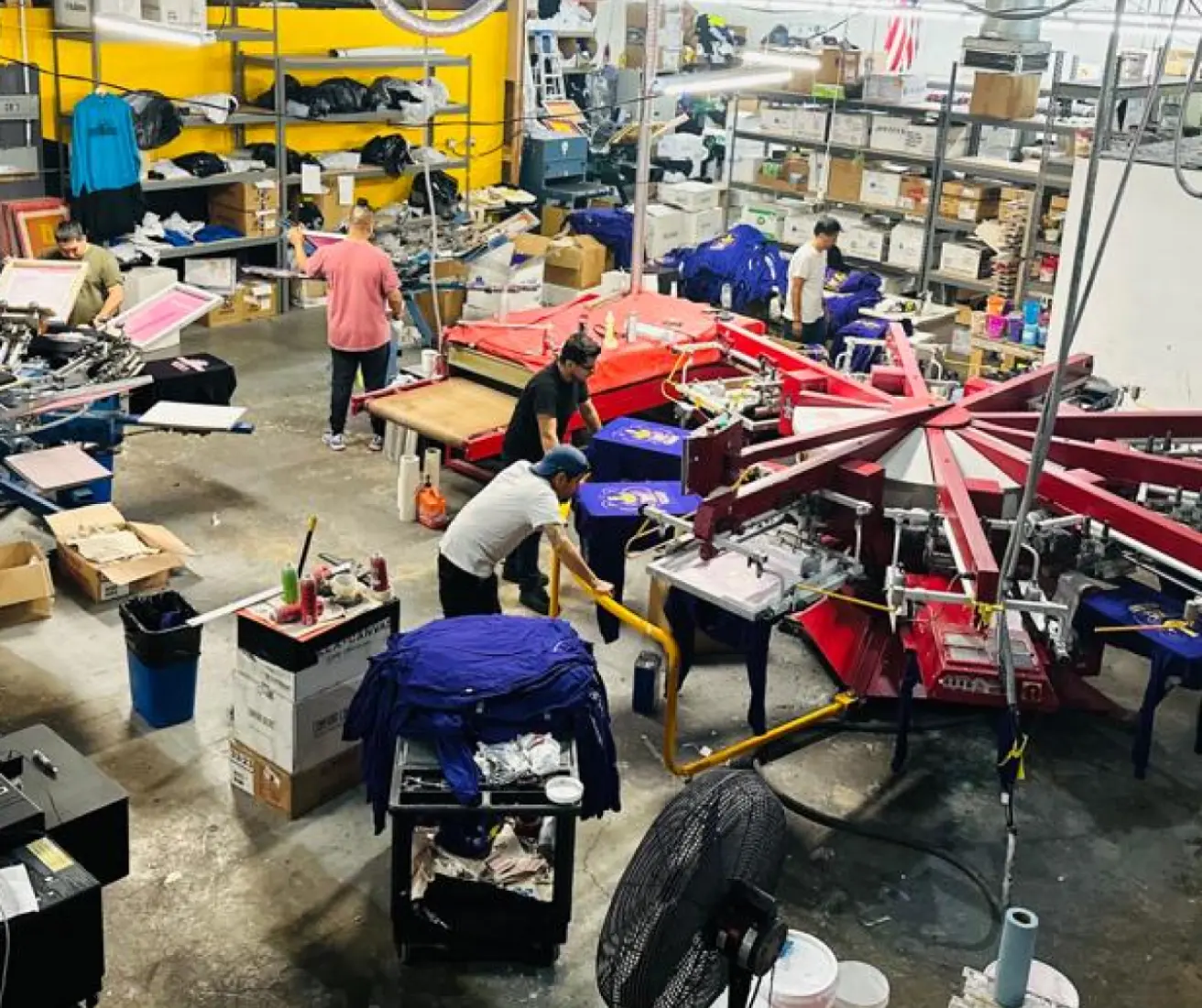Best Local T-Shirt Printing for Personalized Apparel
Wiki Article
Screen Printing Uncovered: Every Little Thing You Need to Find Out About T-Shirt and Garment Printing Strategies
If you've ever wondered exactly how those vibrant styles end up on your favorite tees, you remain in the best location. Display printing is a remarkable approach that combines art with strategy, supplying countless opportunities for imagination. Comprehending the basics, from equipment to ink options, can considerably influence your outcomes. Prepared to check out the vital aspects that make display printing an art form? Let's reveal the details that can elevate your tasks.
The Basics of Display Printing: Just How It Functions
When you plunge into display printing, you'll find it's both an art and a science. At its core, screen printing entails developing a stencil, or screen, that permits ink to pass via only in details areas.Position the display over the fabric, after that make use of a squeegee to press ink with the display onto the garment. Each action is crucial, and grasping them will raise your display printing skills, changing easy garments into special, meaningful pieces.
Sorts Of Screen Printing Methods
As soon as you realize the essentials of display printing, it's time to explore the different methods that can boost your styles. One preferred technique is conventional screen printing, where ink is pushed with a stenciled screen. This strategy is excellent for strong, vivid shades. There's water-based ink printing, which provides a softer feeling and is green, but it needs a various approach to curing.Another option is plastisol printing, known for its durability and vibrant shades, making it a favorite for numerous brand names. Experiment with halftone printing to create slope results and complex layouts.
Vital Equipment for Display Printing
To achieve magnificent lead to screen printing, having the right equipment is fundamental. You'll require a sturdy display printing framework, which holds the mesh that transfers your style onto the garment. Next, purchase premium squeegees; these are necessary for using ink evenly across the screen. You'll additionally call for an excellent exposure unit to produce your displays, in addition to a washout cubicle for cleaning them after use. A reliable warm resource, like a conveyor dryer or warmth press, is essential for healing your prints to ensure durability. Don't neglect a proper work space, furnished with tables and storage space for your supplies. Safety equipment, such as masks and handwear covers, will certainly maintain you secure from chemicals and inks. With the right devices, you'll be well on your means to producing professional-quality prints.Choosing the Right Inks and Products
When picking inks and products for screen printing, you need to take into account the kind of ink that functions finest for your job. Believe regarding material compatibility to ensure your styles look last and great lengthy. Check out environment-friendly ink choices to make your printing procedure a lot more lasting.Types of Display Inks
Selecting the right display ink is vital for attaining vivid, resilient prints that meet your project's demands. There are numerous sorts of screen inks to check out. Plastisol ink is preferred for its flexibility and convenience of usage, giving exceptional color opacity on dark materials. Water-based ink, on the other hand, uses a softer feel and is green, making it suitable for those wanting to decrease their environmental influence. Discharge inks get rid of dye from the textile, leading to a soft, vintage appearance however require particular handling. Lastly, specialized inks, such as metal or glow-in-the-dark, can add distinct effects to your layouts. Review your project demands and select the ink that lines up ideal with your wanted outcome.
Textile Compatibility Considerations
Understanding textile compatibility is crucial for attaining premium screen prints, especially considering that various materials react distinctively to numerous inks. When selecting inks, take into consideration the textile type-- cotton, polyester, or blends. For cotton, water-based inks work well, providing soft qualities and breathability. Polyester, on the various other hand, commonly requires plastisol inks for far better adhesion and vivid colors. You might require to use a mix of both types if you're publishing on blends. Always test your inks on example material to assure they adhere properly and keep color integrity. In addition, bear in mind that fabric weight and appearance can influence the last result, so selecting the ideal ink and material combination is important for your task's success.Eco-Friendly Ink Options
Environmentally friendly inks are becoming a prominent choice for screen printers that want to minimize their environmental impact while keeping high quality. When picking inks, consider water-based inks, which are less unsafe and simpler to clean up contrasted to typical solvents. These inks bond well with fabrics, delivering dynamic results without hazardous chemicals. You could also explore eco-solvent inks that utilize less unpredictable organic substances (VOCs), making them a safer choice for both your wellness and the planet.Additionally, search for inks made from renewable resources, such as soy or vegetable-based options. By choosing the best inks and materials, you'll not just create stunning designs but also add to a more sustainable printing process. Make the switch, and your prints will reflect your commitment to the setting!
Preparing Your Design for Display Printing

File Style Needs
To ensure your layout looks vivid and sharp on fabric, you'll require to pay close focus to file style requirements for display printing. Beginning with vector files like AI or EPS, as they can be scaled without shedding high quality. If you use raster images, choose high-resolution data, such as TIFF or PNG, preferably at 300 DPI. Avoid making use of JPEGs, as they can lose clarity when resized. Make sure your design has a transparent background to protect against unwanted white sides on your prints. Maintain color modes in mind; CMYK is basic for screen printing, so transform your RGB designs accordingly - screen printing kit. By following these standards, you'll establish your artwork up for a successful print.Shade Splitting Up Strategies
Shade splitting up is an essential step in preparing your design for display printing, and understanding it can greatly boost your print top quality. You'll require to break your design into individual colors, as each color requires a separate screen throughout printing. Beginning by determining all the colors in your style and produce layers each. You can make use of software application like Adobe Photoshop or Illustrator to isolate and separate shades successfully. Be certain to conserve each layer as a separate data, usually in a layout like TIFF or PSD. This precision not only ensures accurate color representation but additionally simplifies the printing procedure. By paying interest to color separation, you'll achieve dynamic and professional cause your screen-printed garments.Resolution and Size
Achieving the finest lead to screen printing starts with guaranteeing your layout has the ideal resolution and size. Preferably, your art work ought to go to least 300 DPI (dots per inch) for sharp, clear prints. If you make use of lower resolution, your end product may look pixelated and unprofessional.When it pertains to dimension, think about the measurements of your print location. Style your art work to match the last print dimension, ideally creating it in the actual measurements you'll be publishing. In this manner, you'll prevent any kind of unanticipated scaling issues.
Always inspect your style in both vector and raster formats. Vector graphics can be scaled without losing quality, making them excellent for display printing. Preparing properly will guarantee your style looks incredible on every garment!
Step-by-Step Display Printing Process
Screen printing is a dynamic process that enables you to produce lively designs on numerous surface areas. To get started, you'll need a screen, solution, and your picked ink. Prepare your display by cleansing it extensively. Next off, use the solution uniformly and let it completely dry in a dark area. When dry, expose your screen to light with your design positioned on it, which will solidify the emulsion where the light hits, producing a pattern - screen printing kit.After rinsing the unexposed solution, your display prepares. Establish it up on your printing surface area and straighten your garment beneath it. Pour ink onto the screen and utilize a squeegee to push the ink with the stencil onto the material. Raise the display carefully and let the print dry. Ultimately, cure the ink utilizing warm to ensure resilience. That's it! You have actually efficiently display published your layout.
Tips for Effective Display Printing Projects
While you're diving right into your screen printing projects, remember that prep work is crucial to success. Start by collecting all your products-- inks, garments, screens, and squeegees. A tidy work area assists stop unwanted errors, so clean prior to you start.Next, validate your art work is high-resolution and appropriately sized for your garment. Check your screen for proper direct exposure and clean it thoroughly to stay clear of smudges. When blending your inks, adhere to the supplier's guidelines to achieve the right uniformity.
During printing, apply also pressure with your squeegee for constant outcomes. Don't hurry; take your time to confirm each print meets your criteria. After printing, let your garments completely dry totally prior to dealing with or packaging them.
Last but not least, constantly maintain a sample of your benefit future reference. By doing this, you can evaluate your progression and improve your strategies in time. Satisfied printing!

Frequently Asked Questions
The length of time Does It Take to Set up a Display Printing Work?
Establishing a screen printing task generally takes about thirty minutes to an hour. You'll prepare the displays, mix inks, and change the press. The time differs based on complexity and experience, so remain organized!Can I Publish on Different Textile Keys In Using the Very Same Technique?
Yes, you can publish on different fabric types utilizing the exact same technique, however you'll need to change your inks and settings. Some fabrics take in ink in a different way, so experimenting assurances the most effective outcomes for each product.What Prevail Blunders to Prevent in Screen Printing?
When display printing, avoid typical mistakes like utilizing the incorrect ink, disregarding correct exposure times, or avoiding pre-press checks. Constantly evaluate your configuration and keep clean displays to ensure quality outcomes each time.Just How Can I Effectively Tidy and Keep My Display Printing Tools?
To properly tidy and maintain your screen printing tools, you should on a regular basis wash displays with ideal solvents, examine mops for wear, and assure all tools are saved completely dry and dust-free. Uniformity stops costly repair services and improves efficiency.Is Display Printing Eco-friendly Compared to Various Other Techniques?
Screen printing can be much more ecologically friendly than other approaches, especially if you make use of water-based inks and eco-conscious materials. By choosing lasting products and techniques, you reduce waste and lessen your effect on the earth.Screen Printing Uncovered: Whatever You Required to Know Regarding Tee and Garment Printing Methods
At its core, screen printing includes developing a pattern, or display, that permits ink to pass via only in particular areas. Setting the screen over the material, after that make use of a squeegee to press ink via the display onto the garment. One preferred approach is traditional screen printing, where ink is pushed through a stenciled display.When choosing inks and materials garment printing for display printing, you require to take right into account the kind of ink that functions ideal for your job.
Report this wiki page